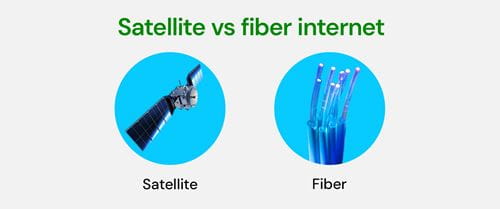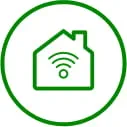Are you stuck choosing between fiber-optic internet and satellite? Wondering what the difference is in technology, price and quality? In this blog we’ll go through both types of internet, so you can determine which one might be best for you.
What is fiber internet?
Fiber internet uses fiber-optic wires to transmit data. These wires are made of thin glass fibers that carry data as light signals. Fiber delivers extremely fast and reliable internet connections, quickly outpacing traditional copper cable networks in speed and reliability.
How fiber internet works
Utility companies or internet service providers install fiber infrastructure by connecting fiber-optic lines via utility poles or underground. Once the infrastructure is established, you can sign up to have the fiber line brought to your house. (If you live in an apartment or condo, contact your landlord, maintenance crew or HOA to find out if fiber is available.) A technician will need to come out to install an Optical Network Terminal (ONT), which converts the optical signal and connects to your router for WiFi. If your home is on the larger side, you may need WiFi extenders to ensure coverage to every corner. Once you’re set up, your connectivity should be good to go.
Read more: How fiber internet gets to your home
Key features of fiber internet
Speed: Fiber internet offers symmetrical speeds that easily surpass 1 Gbps. This means that you can get ultra-fast speeds at the same upload and download rate, which minimizes lag — ideal for bandwidth-heavy activities like streaming, video conferencing, and large file uploads or downloads.
Low latency: Fiber provides very low latency, which means minimal delay when sending or receiving data. Goodbye, buffering wheels! Low latency is crucial for activities like online gaming, VoIP calls, and real-time collaboration.
Reliability: Fiber-optic lines are either attached to utility poles or run underground, like many other utilities. Fiber is less prone to degradation, interruptions from weather or physical obstructions compared to other technologies, offering a more stable and consistent connection.
Scalability: Fiber-optic networks are future-proof, meaning they can easily be upgraded to accommodate faster speeds and higher data usage as technology advances.
Price: Fiber is competitively priced, though as with everything it depends where you are and what you want. At Ziply Fiber, a basic 100/100 Mbps plan runs just $20/month, while robust multigig plans run into the hundreds. The most popular Fiber Gig plan is just $50/month — plus, no contracts or sneaky fees.
Read more: Why you should make the switch to fiber internet
What is satellite internet?
As the name suggests, satellite internet uses satellites orbiting Earth to provide internet access. Data is sent from your device to a satellite dish on your property, which then communicates with satellites in space. These satellites transmit the signal back to a ground station, connecting you to the internet. This is all done through radio waves.
How satellite internet works
A small satellite dish is installed on your property, usually on the roof or a tall structure, to send and receive data. When you access the internet, your satellite dish sends a signal to a satellite in geostationary orbit (about 22,000 miles above Earth). The satellite relays that signal to a ground station, which then connects to the wider internet. The data requested is then sent back to the ground station, relayed to the satellite, and finally transmitted to your satellite dish. Common satellite internet providers include Starlink and EarthLink; CNET recommends HughesNet and Viasat as top picks.
Key features of satellite internet
Availability: Satellite internet is available virtually everywhere, even in remote or rural areas where other types of internet services, like fiber or cable, may not be available. Satellite internet is often a good choice for rural cabins and vacation properties. Satellite internet may also be the preferred choice for boaters, and the dish may be small enough to be carried for on-the-go connectivity. Satellite internet is also good for emergency zones when infrastructure is down.
Installation: A satellite dish needs to be installed on your property, along with a modem inside your home. Some dishes can be installed by the owner — Starlink’s instructions simply say to plug it in and point it at the sky (but getting it up on the roof may require extra help).
Speeds: Most satellite services offer speeds ranging from 25 Mbps to 200 Mbps, which is sufficient for browsing, email and streaming on a few devices but may struggle with high-bandwidth tasks.
Latency: Because the data has to travel long distances to and from satellites in orbit, satellite internet has higher latency. This can result in noticeable delays.
Weather sensitivity: Satellite internet can be affected by weather conditions, such as heavy rain or storms, leading to disruptions in service.
Price: Satellite plans can range into the hundreds per month, plus an equipment fee. Unlike fiber and cable, there aren’t tons of satellite companies in the market — maybe because space isn’t subject to local governments and utility companies.
Read more: Can I use my cellphone for home internet service?
Fiber internet vs. satellite internet: A side-by-side comparison
| Fiber internet | Satellite internet | |
| Speed | Up to 1 Gbps (or higher) | 25-200 Mbps |
| Latency | Very low (milliseconds) | High (up to 600 ms or more) |
| Reliability | High, not usually affected by weather | Can be affected by weather |
| Availability | Growing, but still limited in rural areas | Available almost everywhere |
| Installation | Requires running fiber lines | Requires satellite dish installation |
| Cost | Competitive pricing | Generally $50-$150, but varies by product |
Which is better for you?
Fiber internet might be right for you if…
- You want ultra-fast speeds for activities like 4K streaming, video conferencing or online gaming.
- You have a family or roommates with multiple devices running at the same time.
- You require a low-latency, highly reliable connection for remote work, school, content creation, business or high-demand personal use.
- You are located in an area where fiber infrastructure is available.
- You want a future-oriented solution that will grow and not become obsolete
Satellite internet might be right for you if…
- You live in a remote or rural area where fiber or cable internet isn’t available.
- Your internet usage mainly involves basic activities like browsing, email or light streaming.
- You are okay with occasional weather-related disruptions or slightly higher latency.
- You like the idea of being able to take your internet with you into remote areas.
The final word
Fiber internet and satellite internet are both alternatives to cable and DSL, which are older technologies but still more available and accessible. Fiber internet is the best choice for speed and reliability — but it’s still got a way to go in build-out in many parts of the country. It’s ideal for the modern internet user who needs a lot of data to get through the day, whether for work or play. Price-wise, fiber internet generally runs cheaper than satellite, though multigig speeds will cost more.
While both fiber and satellite internet offer distinct advantages, your choice will depend on your specific needs.
Interested in upgrading to fiber internet? Check your address to find out if we’re on your block.






